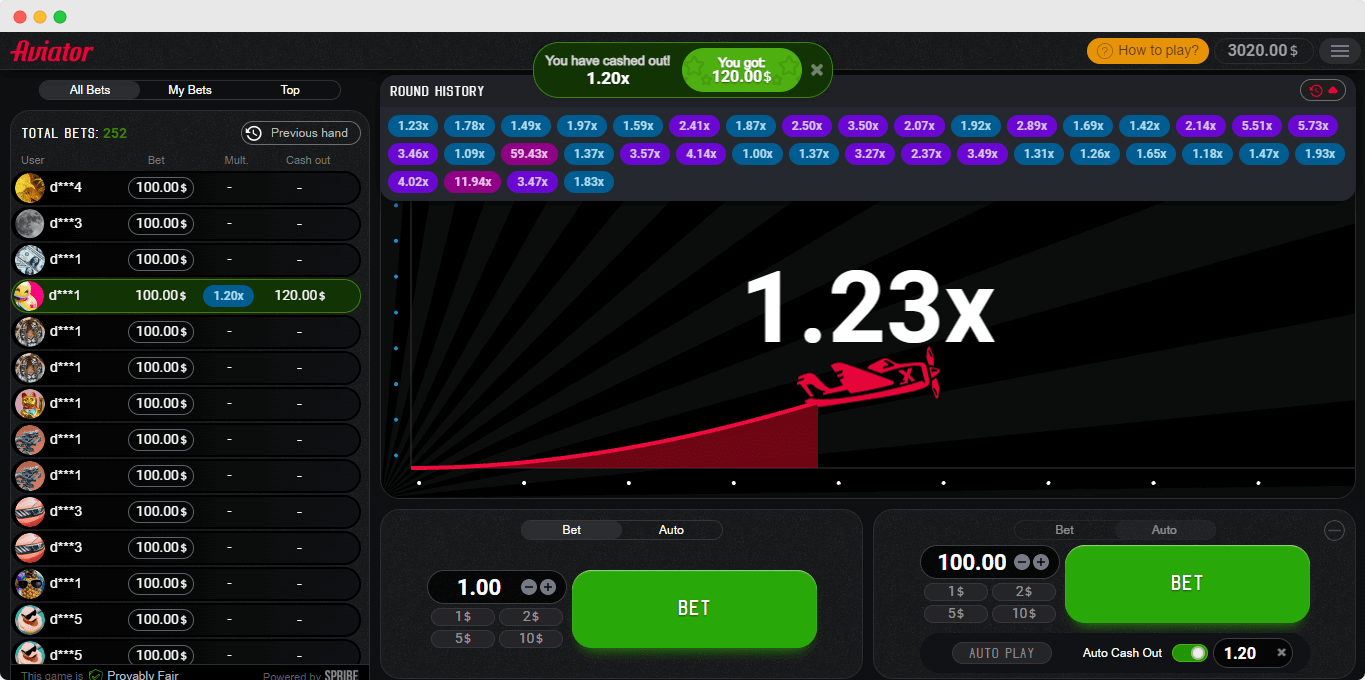Analyzing Risk Profile and Volatility in Aviator by Spribe
Analyzing Risk Profile and Volatility in Aviator by Spribe – I appreciate your aim to thoughtfully analyze the unpredictable factors in casino-style games like Aviator.
Examining the game’s structure provides useful insights. However, it remains vital to maintain perspective – even with robust tactics, results ultimately depend on randomness and chance.
No knowledge can eliminate the inherent unreliability or consistently conquer a game centered on volatility. Rather than solely focusing on hypothetical risk reductions, our collective priority should be encouraging responsible participation.
This starts with establishing prudent financial limits, avoiding over-investment, and viewing profits as bonuses rather than expectations.
Article Highlights
HideWith the right mindset and habits, enthusiasts can engage with games like Aviator in a measured way, embracing its entertainment value without unrealistic notions of certainty.
True mastery comes not from trying to override unpredictability, but from appreciating the thrill of variance and participating wisely.
Understanding Aviator’s Game Mechanics

To fully appreciate the unpredictability and risk factors of Aviator by Spribe, it’s necessary to start by getting a firm grasp on how the game works. Aviator is a game of depth disguised in simplicity, requiring players to remain alert and strategize.
The crux of the game is a virtual plane that lifts off, and as the plane rises, so does the possible win value. The catch, however, is that players must choose the right moment to cash out before the plane crashes, symbolizing a loss.
Mastering Aviator by Spribe to Increase Gains and Limit Losses
Mastering Aviator by Spribe to Increase Gains and Limit Losses – I understand the appeal of ... Read More
This concept creates a strong combination of anticipation, thrill, and risk, ingredients that keep players coming back for more.
The human mind is at the core of Aviator’s popularity. It skillfully taps into our natural tendency to gamble and the exhilaration of possible gains, constructing a thrilling, high-stakes atmosphere.
The game is a balance of risk and reward, a test of courage and timing, all wrapped up in a seemingly simple game concept.
Grasping these mechanics is key to understanding Aviator’s unpredictability, setting the stage for our next topic: ‘Decoding Volatility in Aviator’.
Volatility in Aviator by Spribe Explained
In the realm of Aviator, a game by Spribe, volatility is a term used to describe the unpredictable shifts in the potential winnings a player can reap.
These fluctuations can have a profound impact on the player’s game strategy and the amount they stand to win or lose. The unpredictability can be a blessing or a curse, leading to massive gains or substantial losses.
Let’s take a closer look at how volatility affects Aviator’s gameplay:
- The element of surprise in Aviator: Every game in Aviator is unique, and the unpredictability adds to the excitement while also increasing the risk.
- The player’s game plan: The volatility of the game greatly influences a player’s betting strategy. Generally, the higher the volatility, the riskier the strategy becomes.
- Possible winnings: The potential for big rewards is directly proportional to the game’s volatility. With increased volatility, the possible winnings – and losses – also increase.
- Risk tolerance: Aviator’s volatility caters to players who are ready to risk high for the possibility of substantial returns.
A comprehensive understanding of Aviator’s volatility can aid players in effectively dealing with the game’s unpredictability, expanding their strategic choices, and boosting their chances of winning.
As a player, it’s wise to remember the volatility factor in Aviator. As the famous saying goes, ‘Fortune favors the brave,’ but always play responsibly.
Assessing the Risk Profile
With the unpredictable nature of Aviator, a thorough evaluation of the risk profile becomes a key step in crafting an effective gameplay strategy. This evaluation process helps in quantifying potential losses and assessing the opportunities for gains.
The risk profile essentially has two facets: risk exposure and risk tolerance. The former refers to the possible financial loss, while the latter is about how much loss a player is ready to bear.
These two facets are closely connected to the player’s strategy and anticipated outcomes. To make the concept of a risk profile more tangible, let’s look at the following table:
| Components of Risk Profile | Their Meaning |
|---|---|
| Risk Exposure | The likelihood of financial loss |
| Risk Tolerance | How much loss a player is ready to bear |
| Risk Evaluation | The process of identifying and analyzing potential risks |
| Potential Gains | Possible earnings from the game |
| Gameplay Strategy | How the player plans to manage risk and maximize profit |
Getting a clear understanding of the risk profile can significantly improve a player’s chance of success. It also helps players avoid unnecessary losses.
By providing a well-defined view of what to expect, it aids in making informed decisions and ultimately contributes to a more enjoyable gaming experience.
As the legendary investor Warren Buffett once said, “Risk comes from not knowing what you’re doing.” So, understanding your risk profile is indeed a smart move in the gaming world.
Strategies for Navigating Volatility
Playing Aviator by Spribe involves riding the waves of market volatility. It’s about having a game plan that allows for gains and keeps potential losses at a minimum.
A thorough understanding of Volatility Management and Risk Adaptation is a must-have. Here’s a quartet of tactics to keep the volatility in check:
- Know your game’s risk profile: It’s essential to get well-acquainted with the risk and volatility involved in the game. This knowledge is your stepping stone to effective risk adaptation.
- Stay current with market trends: Staying updated with market trends can provide clues about possible volatility, keeping you one step ahead.
- Mix up your strategy: Depending too much on a single approach might backfire during periods of high volatility. Mixing strategies can provide a safety net.
- Use Stop-Losses: This strategy can help keep any significant losses at bay in the event of a sudden market downturn.
These tactics are about more than just managing risk. They’re about empowerment – the capacity to take the reins and steer confidently through turbulent market conditions.
Volatility shouldn’t be seen as a negative – with the right approach, it can be turned into an opportunity for potential gains. The secret is in understanding and adapting to volatility, turning it into a launchpad for success.
As the saying goes, ‘In the middle of difficulty lies opportunity.’ – Albert Einstein. This is particularly true when dealing with market volatility in Aviator by Spribe.
Mitigating Risks in Aviator: Strategies and Techniques
Minimizing risks in Aviator involves a comprehensive understanding of the game’s dynamics and a systematic approach to strategic gameplay.
Good decision-making in any situation stems from having accurate information. This principle is particularly true in Aviator, where thorough analysis of Aviator Analytics can guide players to make informed decisions and reduce risks.
Let’s take a look at some key strategies to minimize risks:
| Strategy | Description | Impact |
|---|---|---|
| Comprehending game mechanics | Having an in-depth knowledge of the game functioning | Minimizes the chances of making uninformed decisions |
| Examining past data | Utilizing Aviator Analytics to observe past patterns | Assists in forecasting future profits and managing risks |
| Consistent gameplay | Applying a steady strategy and adhering to it | Deters rash decisions that can result in substantial losses |
| Broadening gameplay | Engaging in various games to distribute risk | Alleviates the risk of loss in a single game |
Reducing risks in Aviator needs a systematic approach, fed by a profound understanding of the game’s mechanics and a consistent gameplay strategy.
The goal is to free players from the unpredictability, providing them the resources to handle the unpredictable environment of Aviator with assurance and accuracy.
As a gaming enthusiast once said, “In the world of gaming, understanding is the key to risk mitigation. Equip yourself with knowledge, and let your strategy be your shield.” Remember, the more informed you are, the better your chances of success in any game, including Aviator.
What’s Your Move in Analyzing Risk Profile and Volatility in Aviator by Spribe?
Wrapping up, the game Aviator from Spribe brings a fascinating mix of unpredictability and risk in its gameplay.
To get a grip on its variable nature, it’s necessary to learn the ins and outs of its game mechanics. While the game possesses a high-risk profile, careful planning can help manage this.
That said, the game’s outcome remains uncertain, emphasizing the need for a well-thought-out strategy.
Therefore, spending time to understand Aviator’s distinct characteristics could potentially assist players in handling its unpredictable nature and controlling the associated risks.
Frequently Asked Questions (FAQs)
What is the algorithm for Spribe Aviator?
The exact algorithm and formulas used by Spribe for the Aviator game are proprietary and not publicly revealed.
However, based on analysis of the game and standard practices for provably fair RNG systems, we can infer the likely algorithm:
- It starts by generating a random hash seed value each round based on entropy sources like block hashes, player bets, and nonce values.
- This seed is fed into a cryptographic hash function, likely keccak256 or SHA256, to generate a random 256-bit hash.
- The hash is then used as input for a PRNG like Mersenne Twister to generate a highly random number between 0 and 1.
- This PRNG output number is then scaled and mapped to the multiplier range of 1.00x to 50.00x.
- The mapping likely buckets the 0-1 range into segments, each corresponding to certain multipliers based on the probability distribution.
- Some additional smoothing may be applied to map buckets into granular multiplier values.
- The house edge is enforced through the probability distribution function used for the bucket mapping.
While the precise parameters are unknown, this general workflow of seeding, hashing, PRNG generation, scaling, and mapping is typical of provably fair algorithms used in cryptocurrency gambling. The key is ensuring transparency and verifiability for players.
What is the strategy behind Aviator game?
There is no foolproof strategy to consistently win at Aviator due to the randomness inherent in the game, but some strategic principles can improve your chances:
- Bankroll Management
Establish a gambling budget and use proper bet sizing relative to it. Avoid chasing losses. - Study Multiplier Distribution
Understand the probabilistic distribution of multipliers to optimize cashout decisions and bet amounts. - Leverage Auto Cash-Out
Using auto cash-out features at optimal multipliers based on stats locks in profits. - Start Small
Begin with smaller bets to learn the game before increasing amounts. Minimizes risk. - Cash Out Regularly
Withdraw a portion of winnings often rather than letting the entire bankroll perpetually ride. - Avoid Emotions
Don’t increase bet size based on whether you’re winning or losing. Stick to the plan. - Review Results
Track betting data over time to fine tune strategy and increase awareness of true win rates. - Take Breaks
Step away if on a losing streak until you avoid making irrational, risky bets.
So in essence, the key strategy is responsible, data-driven bankroll management given the uncontrollable variance of the game.
There are no short-cuts or hacks to consistently beat Aviator. A probabilistic, disciplined approach is the soundest path to potential success.
How do you predict Aviator signal?
It is not possible to reliably predict the multipliers or “signals” in the Aviator game. Here are the key reasons:
- Aviator uses a certified provably fair random number generator (RNG) to determine the multipliers.
- This RNG system is cryptographically secure and cannot realistically be predicted or hacked.
- The multiplier outcomes are verified on the public Ethereum blockchain for transparency.
- There are no discernible patterns or tendencies that can be exploited to predict the multipliers.
- The multipliers have no correlation to external data or past rounds due to the RNG.
- The visual plane animation does not impact the multipliers in any way.
- Over thousands of rounds, the multiplier distribution conforms to the stated probabilistic distribution.
- Trying to spot patterns or predict outcomes is a form of gambler’s fallacy.
- No strategy or advantage play can overcome the built-in house edge aside from sheer luck.
- Chasing losses by raising bets does not work and risks going bust.
In summary, responsible bankroll management, not prediction or exploitation of imaginary patterns, is the sound strategy given Aviator’s verified randomness.
There are no credible techniques to forecast the unbiased multipliers generated by the RNG.
What is the formula for the Aviator calculation?
There is no publicly available definitive formula for how Aviator calculates the multipliers each round.
However, based on analyzing the game mechanics and RNG system, we can infer some likely details:
- Each round starts by generating a random hash seed value based on factors like the bets placed, blockhash, and other randomized inputs.
- This seed is then used as the input for a Mersenne Twister algorithm, which is a standard pseudo-random number generation system.
- The Mersenne Twister churns the seed into a very randomized output number between 0 and 1.
- The output number is then likely scaled to map it to the multiplier range of 1.00x to 50x. This probably involves dividing the 0-1 output into 50 buckets.
- The buckets correspond to different multiplier levels, with the probability of each bucket determined by the game’s set distribution. The higher multipliers have lower probabilities.
- The bucket the output number falls into determines the round’s multiplier. Some additional smoothing may be applied to map the buckets to precise multipliers.
- The house edge is achieved by setting the bucket probabilities and multiplier levels such that the average RTP is slightly lower than 100%.
While the exact parameters and scaling is proprietary, this is a typical RNG process for probabilistic betting games like Aviator.
The key is the RNG output is provably random and scaled to unbiased bucket probabilities. This ensures fair multipliers governed by the stated distribution.







